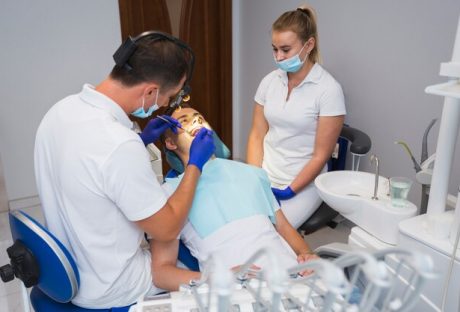Category: Health & Fitness
ContentRally is a leading source of reliable news and trending topics on Health Fitness. Get hard-to-find insights and advice on Health Fitness from industry-specific leaders.

Journeying With The Dying: How Hospice Chaplains Facilitate End-Of-Life Spiritual Transitions
When individuals approach the twilight of their lives, they often confront a whirlwind of emotions—fear, regret, hope, acceptance, and more. This intense period termed the end-of-life phase, sees many grappling with existential questions and seeking answers to life's most profound mysteries. This search for clarity and solace is where the spiritual dimension of human existence comes to the forefront. Many turn to spirituality as a source of comfort, a beacon of hope, and a framework for making sense of their experiences. It's within this complex tapestry of emotions and spiritual quests that hospice chaplains, representing the realm of hospice chaplaincy, emerge as pivotal figures. These professionals dedicate themselves to guiding individuals through this intricate journey, helping them find spiritual serenity amidst the tumultuous currents of approaching mortality. The subsequent sections delve deeper into understanding the multifaceted role of these spiritual caregivers. The Integral Role of a Hospice Chaplain Defining the Role in Greater Detail: Hospice chaplains stand at the crossroads of spirituality and caregiving. They aren't just religious figures; they are trained professionals skilled in offering spiritual support tailored to the unique needs of each individual. Their role goes beyond mere ritualistic practices. They act as confidants, counselors, and guides, providing a listening ear, heartfelt advice, and spiritual interventions tailored to the individual's beliefs and wishes. Whether helping patients find peace with their life's journey, facilitating forgiveness and reconciliation, or simply being present during moments of deep reflection, hospice chaplains are there to ensure that the spiritual dimension of end-of-life care is addressed with the utmost sensitivity and respect. The Spectrum of Interfaith Approaches: One of the most remarkable aspects of hospice chaplaincy is its inclusiveness. Recognizing the diverse tapestry of beliefs and spiritual outlooks in our globalized world, hospice chaplains are trained to cater to various religious and spiritual traditions. Whether a person identifies with a major world religion, a lesser-known spiritual path, or even if they consider themselves secular or agnostic, chaplains are there to provide support. This approach ensures that every individual, irrespective of their belief system, has access to spiritual care that resonates with them. By adopting such an inclusive approach, hospice chaplains affirm the idea that every end-of-life journey is unique and every individual's spiritual needs deserve to be met with understanding, respect, and personalized care. The end-of-life journey is a deeply personal and transformative phase. While medical professionals focus on alleviating physical pain and discomfort, hospice chaplains address the soul's yearnings, questions, and quest for peace. By offering tailored spiritual interventions and an inclusive approach that honors diverse beliefs, they ensure that individuals and their families find the spiritual solace they seek during these poignant moments. Delving Deeper: Spiritual Needs, Interventions, and Family Impact in the End-of-Life Journey Spiritual Needs at the End of Life Seeking Meaning and Purpose: The imminence of death often prompts deep introspection. Many individuals reflect upon their life's journey, trying to discern its purpose. These reflections might encompass personal achievements, missed opportunities, unfulfilled dreams, and significant life events. In such times, spiritual guidance assists individuals in navigating these contemplations, helping them find peace with their life narrative, celebrating accomplishments, and making peace with regrets. Reconciliation: Estrangements and unresolved conflicts become especially poignant during the end-of-life phase. Many individuals desire to reconnect, apologize, or seek forgiveness from loved ones. The urge to mend relationships, settle old disputes, or express unspoken feelings becomes vital. The spiritual guide aids in facilitating these reconciliations, offering counsel, and, if necessary, acting as a mediator. Fear and Hope: The mystery of what comes after death is a source of both trepidation and anticipation. The fear of the unknown contrasts starkly with hopes or beliefs of an afterlife, reincarnation, or spiritual continuation. By addressing these concerns, chaplains help balance these emotions, emphasizing the transformative nature of death in various spiritual traditions. Cultural and Traditional Rites: Every culture and religion has rituals that honor the dying and the deceased. Whether it's a specific prayer, a song, a way, or even silence, these rites are paramount for the person passing and their family. Respecting and facilitating these practices is crucial to providing a sense of closure, continuity, and respect for the individual's spiritual and cultural identity. Interventions by Hospice Chaplains Active Listening: One of the most profound gifts a chaplain can offer is the gift of presence—simply being there, offering a listening ear. By actively listening, they provide a safe and non-judgmental space for individuals to voice their deepest feelings, concerns, and reflections, guided. Meditations and Prayers: Tailoring spiritual practices to individual needs, chaplains might guide patients through meditations or prayers that align with their beliefs. These sessions can instill a sense of calm, acceptance, and connection with the divine or the universe. Scripture Readings: For those who find solace in religious texts, chaplains can read passages that resonate with the patient's current emotions or questions. Scriptures, whether from the Bible, Quran, Torah, Bhagavad Gita, or other religious texts, can offer comfort, guidance, and a sense of continuity. Ritual Facilitation: Be it sacraments, candle lighting, or even non-religious rituals like listening to a specific song or watching a sunset, chaplains assist in organizing and facilitating these rites, ensuring the Grief Support: The dying process isn't just about the individual; it encompasses the family and loved ones. Chaplains extend their support to these grieving souls, offering a shoulder to lean on, words of comfort, and guidance through their emotional journey. The Impact on Families Emotional Anchoring: In the tumultuous sea of emotions, chaplains act as an anchor for families. Their calm presence and experience in navigating such situations provide a stabilizing effect, helping families cope more effectively. Guidance through Rituals: Families often seek direction in performing end-of-life rituals correctly and meaningfully. Chaplains offer insights, respect cultural nuances, and sometimes even take the lead in ensuring these rites are conducted reverently. After-death Support: The journey doesn't end with the passing of a loved one. Grief, memories, and the void left behind are real and profound. Chaplains continue to support families, providing bereavement counseling, helping them process their loss, and guiding them toward healing and acceptance. The spiritual dimensions of the end-of-life journey are intricate, deeply personal, and encompass more than just the dying individual. Hospice chaplains, with their nuanced understanding, play an instrumental role in ensuring that this journey, for both the individual and their families, is navigated with dignity, respect, and profound compassion. Continuous Education and Self-care Training: The importance of ongoing training for chaplains to stay updated on best practices and religious rites. Self-care Rituals: Chaplains must cultivate personal rituals or practices to manage their well-being. Peer Support: Engaging with fellow chaplains or professionals to discuss challenges and share experiences. Conclusion The journey towards the end of life is deeply personal, and the spiritual terrain can be complex. Hospice chaplains, with their expertise and compassion, play an indispensable role in facilitating spiritual transitions during this phase. Their ability to address the deep-seated spiritual needs of the dying and their families ensures that the end-of-life journey is one of meaning, reconciliation, and peace. Read Also: Navigating Healthcare: Exploring The Harvest Tech Achievers ETF Seven Stages To Creating A Patient-Friendly Healthcare App The Future Of Healthcare: Adapting To An Aging Society
READ MOREDetails
Self-Care Deficit Nursing Theory In Adult Gerontology Nursing
Any Adult Gerontology Nurse Practitioner (AGNP), or individual considering moving into this booming area, will probably be aware that it involves more than supporting patients through short term illnesses or meeting their needs in a hospital or nursing home. As a rule, the older a patient gets, the more likely they are to experience chronic health complications which interfere with their day-to-day tasks. For much of history, such patients were written off, encouraged to take to their beds and be supported entirely by others, doing very little. They often didn’t live very long. But all that changed on account of one remarkable nurse, Dorothea Orem, whose legacy continues to shape the nursing profession today. This article examines her groundbreaking self-care deficit theory and looks at how AGNPs might use it for their nursing career. Dorothea Orem Dorothea Orem was born in Baltimore in 1914 and studied nursing in the late 1930s. This was a time when nursing schools were still a new phenomenon and there was a lot of experimental thinking in the nascent profession. Though she spent time on the wards as a staff nurse, she also worked as an administrator and consultant over the course of her career, spending her later years focusing on theory. A naturally focused and attentive person, she soon began recording observations about the patients she worked with, leading to her self-care deficit theory of nursing, for which she strongly advocated for her entire life. It was theory which, in its early years, transformed the way nurses thought about patients and their duties. It laid the foundations for nursing today. Universal Self-Care Requisites Orem’s theory recognizes eight universal self-care requisites, or SCRs. Here, universal refers to things every human needs, regardless of circumstance. Air is needed for respiration. Water is needed to maintain a healthy level of hydration. Food is needed to maintain healthy energy levels and prevent starvation. Elimination or toileting, a polite way of referring to the expulsion of urine and feces from the body, is required too. In addition to these four things, Orem posits that every patient needs a balance of physical activity and rest. Everyone needs social interaction, but also some alone time. People need to manage their lives to avoid or remove hazards, and, finally, they need to promote normality. This means that they need to achieve and maintain a way of living and relating to the world which is normal for them as individuals and does not involve psychosis. Health Deviation Self-Care Requisites When patients are recovering from injury or illness, or living with a chronic illness or disability, they can be described as experiencing a health deviation. This is not pejorative – it simply establishes that they differ from the norm. Health deviations are more common in older demographics, as they have additional self-care requisites. These requisites include following doctors’ instructions (taking medicine on time), identifying problems caused by their conditions and attending to them effectively (sitting down until a dizzy spell passes), and knowing when and how to seek help from a caregiver or healthcare professional. It is also important that these patients can understand and accept that their bodies have changed and can adjust psychologically to cope with it. What Is A Self-Care Deficit? A self-care deficit occurs when people are no longer able to carry out basic tasks. This can be because a disability makes them physically impossible to perform, or a number of other reasons. For example, some people get so overwhelmed by the way their bodies have changed that they stop trying to live. This doesn’t mean that they don’t deserve sympathy – it is an understandable response to an extreme situation – but it might mean that there is potential for improvement. For some people, self-care deficits are permanent or are likely to worsen due to progressive illnesses. For others, however, they can be temporary, even in extreme old age. Self-care deficits stemming from a broken arm, for example, will normally dissipate after the arm heals, but this is less likely if the patient has learned to feel helpless in the meantime. Assessment, Diagnosis, And Implementation When using Orem’s theory, nurses have three steps to work through. The first is undertaken during the initial assessment of a new patient and involves identifying any self-care deficits. These are not always obvious from looking at a patient and the process may require gentle but persistent questioning. Some people may be embarrassed and hesitant to talk if they are unable to care for themselves. The second involves full diagnosis of the deficits, including establishing causes. The third step is to draw up a treatment plan based on these diagnoses. In her work, Orem stressed the importance of recognizing that every patient is a unique individual, so there is no one-size-fits-all approach to this type of planning. In each case, AGNPs will need to work with the patient to establish the most effective way forward. Five Ways Nurses Can Help There are five strategies nurses can use to address self-care deficits when establishing patient care plans: For the most severely incapacitated patients, it may be necessary to perform actions on their behalf, such as washing or dressing them. Patients struggling mentally or who lack confidence can be guided through actions, ideally to the point of independence. Patients can be taught new ways of approaching day to day tasks which make them easier to accomplish, such as taking a break to have a shower in the afternoon if it is too hard to find the energy at other times. AGNPs can focus on the patient’s environment, making it easier for them to carry out self-care activities, such as suggesting kitchen gadgets to reduce the physical effort involved in preparing meals. Finally, AGNPs can train a family caregiver to provide appropriate support. These five strategies involve numerous actions, skills, and tools that nurses can use. Patients may need particular assistance with the following tasks. Helping With Eating Patients should always be encouraged to do as much for themselves as is reasonably possible. When it comes to eating, nurses should start with encouragement. Many older people lose their appetite and don’t feel motivated to eat, especially when it requires effort. So, an AGNP can point out that they have more energy when they manage to eat regular meals. If the patient can get food to their mouth by themselves, nurses should resist the temptation to assist, even if they sometimes drop the food. Instead, nurses can reassure them that this is not uncommon and all they need to do is take a little more time. Nurses should also be alert to the possibility of choking issues and arrange X-rays if concerned. If some food proves difficult to eat, they can discuss the possibility of dietary adjustments. Helping With Toileting Nurses should reassure patients that, awkward as they may feel, there is nothing to be embarrassed about. The nurse must ensure they can transfer on and off the toilet safely and consider options like raising the height of the seat or installing grab. If there is a risk of falling, AGNPs may suggest bedpans for use when no caregiver is present. If adult diapers are needed, nurses should ensure that patients know how and when to change them (even if they are not soiled) and how to protect their skin against rashes or bruises caused by wearing them. Finally, nurses can also discuss medical options for softening stools or speeding up or slowing down digestive transit. Helping With Dressing And Grooming A balance must be struck between helping patients be more independent in dressing and grooming themselves and enabling them to maintain a style or standard of appearance that is natural for them. Some older men prefer to be clean shaven but end up growing beards because it is easier to trim a beard than it is to shave safely and neatly, for example. Some clothing options can be easier to get into than others, depending on a patient’s particular mobility difficulties. Simple devices such as a stick with a hook on the end can make adjusting the back of a garment or doing up a zip much easier. Nurses should pay particular attention to footwear to make sure patients can stand or walk safely. Reducing Hazards Whether a nurse is helping a patient to move around and complete self-care tasks in a hospital ward, a care home, or their own home, they must always pay attention to hazard prevention. Hazards can include mess, a layout created without regard for disability, or other people or pets moving around. Nurses can start by ensuring that the patient is aware of the risks and can recognize dangerous situations. They should discuss simple measures like installing handrails or changing routines to make it easier to keep the area tidy. Nurses can also ensure that the patient can summon help if something goes wrong, by persuading them to install an alarm system or carry a charged mobile phone at all times, for example. Care With Communication Often, older patients who have self-care deficits also have difficulty with communication, whether due to physical or cognitive disability. Depending on their lifestyle in recent years, they may also be unfamiliar with modern technologies, but shy about admitting this. It is important for nurses to make sure that when they are addressing issues around essential needs, the patient understand them properly and vice versa. It can be helpful to use pictures in communication, which are often available in support materials. When meeting a patient in the place they are going to be living, the nurse and patient can explore it together (in stages, if necessary) so both parties can directly identify issues. Seeing Each Patient As An Individual An essential tenet of Orem’s theory is that patients must be treated as individuals. This increases the chance that they will stick to treatment plans, as well as directly improving their psychological wellbeing. Any nurse that’s interested in Orem’s theory and is considering joining this field will be looking into gerontology nurse practitioner programs online. The best courses place a lot of emphasis on adaptability and on learning how to manage different types of patients in different environments. The program at the University of Indianapolis, for example, encourages students to develop the patience and listening skills essential to getting to know patients and making them a part of the process. This communication and relationship building is essential to developing plans which will really benefit patients over the long term. The course at the University of Indianapolis is an eight-semester program designed for working nurses, involving part-time study and an intensive clinical placement. The Nursing Profession Continues To Benefit Thanks to Orem and her self-care deficit theory, patients are no longer left to waste away as they begin to struggle with old age. Generations of nurses who have practiced this theory have observed that, even in later life, patients can often improve and regain their self- care abilities with the right support. Advances in assistive technologies continue to make this even easier. The right support, focused on facilitating and encouraging independence, enables seniors to go on living satisfying lives on their own terms for much longer. Even when they need extensive practical support, giving them more control helps to maintain their morale and ability to navigate the final chapter of their lives. In the process of providing this support, AGNPs also get what they really want; to see their patients thrive, no matter what they must overcome to achieve it. Additionals: 8 Awesome Health Benefits Of Dark Chocolate Psychedelic Therapy for Mental Health Conditions How Does Children’s Health Impact Parental Lifestyle?
READ MOREDetails
The Ultimate Guide To Finding The Best Dentist In Vaughan
Are you in search of a reliable and skilled dentist in Vaughan to take care of your dental health? Look no further; this comprehensive guide will walk you through the process of finding the perfect dentist who meets your needs. We understand that choosing a dentist is a crucial decision for your overall well-being, and we're here to make that choice easier for you. So, are you excited? Let’s get started, then… Why Choosing the Right Dentist Matters Your oral health is intricately connected to your overall health, making it essential to have a trustworthy dentist in your corner. Regular dental check-ups and treatments can prevent dental issues, enhance your smile, and boost your self-confidence. Let's dive into the key factors to consider when searching for the ideal dentist Vaughan. Poor quality dental work is important not only for your oral health but also for your entire body. Dental concerts can go unchecked without a quality dentist, especially the ones who do not leverage the latest technology. You are more likely to feel comfortable and visit them often if you have a great dentist in place. Hence, there is no second thought about changing your dentist after some intervals. Factors to Consider When Choosing a Dentist When embarking on your journey to find a dentist in Vaughan, there are several crucial factors to keep in mind. After all, you are trusting your oral health with them. Hence, make sure you make an informed decision and do not hurry while choosing a dentist for yourself. 1. Location and Accessibility Choosing a dentist near your home or workplace can save you time and make it more convenient to attend appointments. Ensure that their office hours align with your schedule, making it easy to get the care you need. 2. Qualifications and Credentials It's vital to check if the dentist has the necessary qualifications and credentials. Look for a dentist who is licensed and a member of reputable dental associations. When it comes to finding the best dentist for you, educational qualifications play an indispensable role. 3. Services Offered to Consider your specific dental needs. Are you looking for general dentistry, orthodontics, cosmetic dentistry, or specialized services? Ensure the dentist offers the treatments you require. An ideal dentist will usually provide a range of services that are usually needed for an overall oral health checkup. 4. Experience and Expertise An experienced dentist is more likely to provide effective treatments. Research the dentist's background and the number of years they've been in practice. Both expertise and experience play an integral role in separating a dentist from others. 5. Testimonials And Reviews From Patients Going through testimonials and reviews shared by past patients can offer valuable insights into the dentist's quality of care. It also provides patient satisfaction. 6. Technology and Equipment Modern dental technology can improve the accuracy and comfort of dental procedures. Inquire about the equipment and technology used by the dentist. You might check out the equipment used by other dentists and then come up with a decision. If a dentist doesn’t make use of the latest technology, he is probably missing out on a lot of advancements. 7. Payment Options and Insurance Check if the dentist accepts your insurance plan or offers convenient payment options to ensure affordability. Today, everybody looks for different payment options, and they are not limited to just one option. What’s better than providing patients with the liberty to pay for their free will? 8. Emergency Services Consider whether the dentist offers emergency dental services for unexpected oral health issues. This is just in case something comes up without any signs; you will be saved from unprecedented situations. A dentist’s ability to act as soon as an emergency comes is one of the most appreciated ones. 9. Personal Comfort Your comfort at the dental office is crucial. Evaluate the cleanliness, ambiance, and friendliness of the staff during your initial visit. If you do not find the ultimate comfort at your dentist’s office, there is no point in spending a significant amount of time and money there. Personal comfort is quite important here. Related: Why Going To The Dentist Is A Must The Search Process Finding a dream dentist is not a challenge, although you might need to consider a few factors. There are so many competitors out there that you might get confused. But don’t be! Now that you're aware of the factors to consider, here's a step-by-step guide to finding the perfect dentist in Vaughan: A. Create a List Compile a list of potential dentists in Vaughan based on referrals from friends, family, or online searches. Creating a list is not only the first step to finding a dentist but also the only streamlined way to find out the best dentists in and around your locality. B. Research Thoroughly research each dentist on your list. Check their websites, credentials, and patient reviews. If needed, you might try scrolling through their social media channels and then settle for one that suits your needs perfectly. C. Schedule Consultations Narrow down your list and schedule consultations with your top choices to discuss your dental needs and assess their compatibility. Scheduling appointments is an obvious step, but some might underestimate their importance in finding out the best dentists in Vaughan. D. Ask Questions During the consultations, don't hesitate to ask questions about their experience, treatment options, and payment plans. You might enquire about your appointments, your entire treatment process, and how long it will take to view results. E. Trust Your Instincts Choose the dentist with whom you feel most comfortable and confident. After all, it is always about going as per your instincts. If you do not have a good feeling about a dentist, enquire and avoid them if possible. Conclusion Finding the best dentist in Vaughan is a significant step towards maintaining excellent oral health. By considering location, qualifications, services offered, and personal comfort, you can make an overall informed decision that will benefit your smile and overall well-being. Read Also: Finding A Leading Melbourne Dentist For The Perfect Smile The Differences Between A Dentist and An Orthodontist Emergency Dental Clinic Immediate Care When You Need It Most
READ MOREDetails
Understanding The Rehabilitation Process A Journey To Recovery
In today's fast-paced world, the need for rehabilitation is a reality that many individuals face. Whether it's recovering from a sports injury, surgery, or addressing substance abuse issues, the rehabilitation process plays a crucial role in restoring one's physical and mental well-being. So, in this comprehensive guide, we'll delve into the intricate details of the cocaine rehab canada process, offering insights. At the same time, we intend to provide guidance and answers to some common questions you may have. Rehabilitation Rehabilitation is a holistic process aimed at helping individuals regain their physical, mental, or emotional well-being after facing a setback. It encompasses various forms, depending on the condition's nature and the rehabilitation process's goals. Types of Rehabilitation As mentioned above, rehabilitation helps an individual get oneself on track. Again, they help one get the right time for recovery and ensure that the individual has a great career ahead. However, we discuss some rehabilitation types here in this section. 2.1 Physical Rehabilitation Physical rehabilitation focuses on restoring physical function and mobility. Hence, it is a common prescription for individuals recovering from surgeries, accidents, or injuries. 2.2 Occupational Rehabilitation Occupational rehabilitation helps individuals regain skills needed for daily life and work. This type of rehabilitation is often necessary after prolonged illnesses or injuries. So, this type of rehabilitation is often necessary after prolonged illnesses or injuries. 2.3 Substance Abuse Rehabilitation Substance abuse rehabilitation is a vital part of the recovery process for those struggling with addiction. It addresses the physical and psychological aspects of addiction. The Rehabilitation Team The Rehabilitation Team The efficacy of rehabilitation lies to an extent in a good team of professionals. At the same time, their coordination and observation determine the success of the recovery process. This very section sheds light on the nitty-gritty of team building. 3.1 Physicians and Specialists The rehabilitation process begins with a team of medical professionals who assess the patient's condition and create a tailored plan for recovery. 3.2 Therapists Therapists play a crucial role in rehabilitation, providing physical, occupational, or psychological therapy to facilitate recovery. 3.3 Support Staff Support staff, including nurses and caregivers, offer invaluable assistance and care throughout rehabilitation. The Initial Assessment One of the primary steps in the rehabilitation process is the initial assessment in this stage. The team of experienced professionals performs different tests to understand the issue and the depth of the problem. After the entire study is conducted, the team of experts moves on to the next stage, which is strategizing the entire rehabilitation of the individual. 4.1 Setting Goals Establishing clear rehabilitation goals is the first step. These goals provide a roadmap for recovery and motivate the individual to progress. In general, the tenure of an athlete is quite short. So, the person would definitely understand the length of the rehabilitation. The sooner it is set, the better it can be. Hence, goal setting becomes one of the important aspects linked directly with goal setting. 4.2 Creating a Personalized Plan A personalized rehabilitation plan is then developed, outlining the specific treatments, therapies, and milestones to achieve during the rehabilitation journey. A personalized rehabilitation plan has its own advantages. At the same time, it helps one be motivated and charged up for the entire recovery stage. Simultaneously, it helps the team of professionals oversee the entire procedure and flow of the rehabilitation. The Rehabilitation Journey Rehabilitation is a comprehensive and lengthy process in itself. It is akin to a journey. Hence, you can understand the flow or important elements associated with the recovery process. 5.1 Phase 1: Assessment and Evaluation The initial phase involves thorough assessments to understand the individual's current condition. It sets the foundation for the rehabilitation plan. Through the continuous process, the professional tries to frame the probable pathway for recovery or rehabilitation. At the same time, they engage themselves in talks and discussions mainly to understand the process of recovery. Ultimately, it brings clarity to understanding the journey of recovery. 5.2 Phase 2: Treatment and Therapy Treatment and therapy are implemented to address the identified issues. This phase requires dedication and patience as individuals work toward their goals. 5.3 Phase 3: Monitoring and Adjustments Regular monitoring ensures progress, and adjustments are made to the rehabilitation plan as needed to optimize results. Challenges and Triumphs The pathway to rehabilitation is complex, and it is time-consuming, thats for sure. From an athlete's perspective, the entire wellness journey goes through its highs and lows. At times, there will be frustration, and one might experience the joy of attainment. But the team of professionals continuously pumps up the care user. 6.1 Overcoming Plateaus Plateaus in recovery are common, but with the right support and determination, individuals can push through and continue progressing. 6.2 Celebrating Milestones Celebrating small and significant milestones along the way boosts motivation and provides a sense of accomplishment. Emotional Well-being in Rehabilitation At times, the entire journey of rehabilitation becomes emotional. The athlete goes through both the pain and frustration of slow recovery, agony, and the fear of the future. But also, at the other end, there is the victory, the triumph of winning through the recovery stretches. 7.1 Coping with Frustration Emotional challenges are an integral part of the rehabilitation process. Learning to cope with frustration and setbacks is crucial. These are testing times, and the team of professionals goes through the entire journey together. It works as a psychological stimulus for the athlete. 7.2 Building Resilience Building emotional resilience is a key aspect of rehabilitation. It equips individuals to face challenges with a positive outlook. Preparing for Life Beyond Rehabilitation The final stage is preparation for life. Here, the athletes complete the last rehabilitation stage before returning to normal life. 8.1 Transitioning to Independence As rehabilitation nears completion, individuals prepare to transition back into their daily lives, often with newfound independence. 8.2 Maintenance and Preventative Care Maintenance and ongoing care are essential to ensure the long-term success of the rehabilitation process. Conclusion The rehabilitation journey is a testament to the human spirit's resilience and determination. It offers a path to recovery, enabling individuals to reclaim their lives and move forward with renewed vigor. Read Also: What Is Thinspo? | Impact On Physical And Mental Health 5 Mental Health Benefits of Massage Therapy That You Must Know When Will Social Media Addiction Be Considered a Mental Health Condition?
READ MOREDetails
Emergency Dental Clinic Immediate Care When You Need It Most
In today's fast-paced world, unexpected situations can arise at any moment, including dental emergencies. Whether it's a severe toothache, a knocked-out tooth, or a broken dental appliance, having access to an emergency dental clinic toronto can make all the difference in the world. In this comprehensive guide, we will explore the importance of emergency dental care, what to expect during a visit, and how to find the nearest emergency dental clinic in your area. Understanding Dental Emergencies Dental emergencies can happen suddenly and often result in severe pain or discomfort. Common dental emergencies include: 1. Severe Toothache A persistent and agonizing toothache could indicate an underlying issue that requires immediate attention. 2. Knocked-Out Tooth Accidents can lead to a tooth being knocked out of its socket. Quick action can sometimes save the tooth. 3. Broken Or Chipped Teeth Broken or chipped teeth can result from accidents, sports injuries, or biting on hard objects. 4. Lost Dental Filling or Crown A lost filling or crown can expose the sensitive inner layers of your tooth, causing pain and discomfort. The Importance Of Emergency Dental Care Emergency dental care is crucial for several reasons: 1. Pain Relief Dental emergencies often cause severe pain. Immediate care can provide much-needed relief. 2. Preventing Further Damage Addressing dental emergencies promptly can prevent the situation from worsening. 3. Saving Teeth In cases of knocked-out teeth, rapid treatment increases the chances of saving the tooth. What To Expect At An Emergency Dental Clinic When you visit an emergency dental clinic, you can expect: 1. Evaluation The dentist will assess your condition, possibly through X-rays, to determine the extent of the issue. 2. Immediate Treatment Depending on the diagnosis, the dentist will provide immediate treatment, such as extraction, filling, or pain management. 3. Follow-Up Care You may need additional appointments for follow-up care to ensure your dental health is fully restored. Finding The Nearest Emergency Dental Clinic In a dental emergency, time is of the essence. To find the nearest emergency dental clinic: 1. Internet Search Use search engines to find emergency dental clinics in your area, and check their reviews and ratings. 2. Ask For Recommendations Seek recommendations from friends, family, or your regular dentist for reputable emergency clinics. 3. Local Directories Consult local directories or contact your local dental association for a list of emergency dental clinics. When dental emergencies strike, having access to an emergency dental clinic can make all the difference in your comfort and oral health. Don't hesitate to seek immediate care when needed, as timely intervention can prevent further complications and save your teeth. Read Also: The Process of Invisalign How To Get a Better Smile Whatever Your Budget What Is A Good Alternative To Wearing Dentures?
READ MOREDetails
The Chemistry of Rush Poppers: What Every User Should Know
Rush poppers have long held a place in popular culture, often surrounded by curiosity, misinterpretation, and a hint of intrigue. These small bottles, typically found in adult novelty stores or online, promise their users a brief rush of euphoria. Over the decades, rush poppers have seen varied responses from the public, leading to numerous myths and misconceptions. Understanding its chemistry and effects on the body is crucial, as with any substance. This article delves into the science behind rush poppers, breaking down what every user—and potential user—should know about their composition and impact. What are Rush Poppers? Rush poppers, often referred to as 'poppers,' have a history dating back to the late 19th century. Initially introduced as a treatment for angina, their medicinal use dwindled with the advent of more advanced cardiac medications. However, their recreational popularity surged during the 1970s and 1980s, particularly within the gay community. Most commonly, rush poppers are found in small liquid-filled bottles under various brand names, with "Rush" being one of the most recognized. When inhaled, these volatile liquids produce a short-lived, euphoric 'rush,' contributing to their enduring allure. The primary ingredient in these formulations is alkyl nitrites. While they were once primarily amyl nitrites, the composition has shifted over the years, with isobutyl nitrite now being more prevalent in today's market. Their legal status varies globally, with some countries allowing their sale as 'room odorizers' or 'leather cleaners' to bypass health regulations. Nonetheless, the cultural footprint of rush poppers remains significant, prompting occasional and regular users to delve deeper into their chemistry and effects. The Chemistry Behind the Rush The potent effects of rush poppers can be attributed to their chief chemical constituents: alkyl nitrites. Alkyl nitrites, whether amyl, butyl, or isobutyl, are volatile organic compounds that, when inhaled, rapidly enter the bloodstream. Their fundamental action revolves around the relaxation of smooth muscles found throughout the body, including the walls of blood vessels. When an individual inhales the fumes from rush poppers, the alkyl nitrites lead to vasodilation or the widening of blood vessels. This sudden expansion causes a rapid decrease in blood pressure, resulting in the characteristic 'head-rush' sensation. The brain experiences a brief influx of oxygen, producing euphoria and lightheadedness. This effect is often accompanied by sensations of warmth, dizziness, and an increased heart rate. But what's the chemistry making this happen? Alkyl nitrites function as a source of nitric oxide, a signaling molecule in the body. Nitric oxide's release prompts the relaxation of vascular smooth muscles, creating the vasodilatory effect. While the experience may be exhilarating for some, it directly results from a chemical interaction with the body's physiological systems. The fleeting nature of rush poppers' effects, which usually last just a few minutes, is due to the rapid metabolism and elimination of alkyl nitrites from the system. How Do Rush Poppers Work in the Body? To fully grasp the rush and allure of poppers, one must delve into their interaction with our physiological systems. Upon inhalation, the vapors from rush poppers are rapidly absorbed by the lungs into the bloodstream. Once in the blood, alkyl nitrites exert their primary effect: relaxing smooth muscles. This is not limited to vascular muscles but extends to other body areas, which explains some of the sensations users report. The immediate dilation of blood vessels causes a swift drop in blood pressure, inducing a feeling of lightheadedness. This 'head rush' is, in essence, a surge of oxygenated blood to the brain, accompanied by a warm sensation, potential facial flushing, and an accelerated heart rate. Additionally, the relaxing effect of rush poppers on other smooth muscles can lead to enhanced sensations, particularly during intimate activities, which contributes significantly to their recreational appeal. While the sensations might be described as intense by users, they're typically short-lived, often waning within a few minutes. This transient nature results from the body's efficient processing and elimination of the inhaled alkyl nitrites. The Risks and Safety Concerns Like any substance that has a profound effect on the body, rush poppers come with their set of risks and safety concerns. While many users report minimal adverse effects when used sporadically and responsibly, potential dangers can emerge with misuse. One immediate concern with rush poppers is the potential for a sharp drop in blood pressure. The additive effect can lead to fainting, dizziness, or even more severe cardiovascular issues for individuals already on medications or with conditions that lower blood pressure. Moreover, alkyl nitrites can produce harmful effects when combined with other substances. For instance, when used alongside erectile dysfunction medications like Viagra or Cialis, there's a heightened risk of a dangerous drop in blood pressure. There's also the concern of chemical burns. Given the volatile nature of the liquid, if it comes in direct contact with the skin, it can cause irritation or burns. Plus, ingestion or swallowing can lead to severe poisoning and requires immediate medical attention. On the legal front, the sale and possession of rush poppers vary by jurisdiction. In some regions, selling them for human consumption is prohibited, leading vendors to market them as 'room deodorizers' or 'cleaning agents'. This guise, however, does not reduce the risks associated with their misuse. While rush poppers might promise a fleeting euphoria, users should approach with informed caution, understanding the potential ramifications on their health. Common Misconceptions and Myths The allure and mystique surrounding rush poppers have created many myths and misconceptions. One common fallacy is that poppers are entirely harmless, a belief stemming from their short-lived effects. While they might not lead to long-term dependency like other substances, their misuse can pose significant health risks, as previously discussed. Another myth is that they're aphrodisiacs. While rush poppers can heighten sensations and relax muscles, attributing aphrodisiac properties to them is misleading. Their physiological effects might enhance intimate experiences but don't inherently increase sexual desire. Being armed with facts over fiction is essential when considering or using poppers. Conclusion The world of rush poppers, veiled in intrigue, promises a brief, euphoric escape. Yet, understanding their chemistry, physiological impact, and associated risks is paramount. By being informed, users can make safer decisions, ensuring their experiences with poppers are enjoyable and without undue harm. Read Also: How To Make Doing Yoga At Home Interesting 11 Effective Ways To Improve Testosterone Levels In Your Body What Is Garcinia Cambogia And How It Can Help Your Health? What Are Virtual Reality Workouts And How Will They Affect Exercise?
READ MOREDetails
Cocaine Addiction In Canada A Growing Crisis
In recent years, Canada has been grappling with a growing crisis that has far-reaching consequences for individuals and society as a whole - cocaine addiction. This pervasive issue has taken root in various regions across the country, affecting people from all walks of life. In this article, we will delve deep into the world of cocaine addiction Canada, exploring its causes, effects, treatment options, and the road to recovery. Understanding Cocaine Addiction The Rise Of Cocaine In Canada Cocaine, a powerful stimulant derived from the coca plant, has been on the rise in Canada. It is a highly addictive substance that can be consumed in various forms, including powder and crack cocaine. The affordability and accessibility of cocaine have contributed to its increasing prevalence in Canadian cities. The Demographics Of Cocaine Addiction Cocaine addiction knows no boundaries. It affects individuals of all ages, genders, and backgrounds. We will take a closer look at the demographics of those most at risk and explore the factors that make certain groups more vulnerable to addiction. The Causes And Effects Of Cocaine Addiction The Root Causes Cocaine addiction often stems from a complex interplay of factors. We will examine the underlying causes, including environmental, genetic, and social factors that contribute to the development of addiction. Physical And Psychological Effects The effects of cocaine addiction are far-reaching and devastating. From physical health problems to psychological issues, we will explore the toll that cocaine takes on an individual's well-being. Seeking Help: Treatment And Recovery Recognizing The Signs It is crucial to recognize the signs of cocaine addiction early on. We will provide insights into the behavioral and physical indicators that can help loved ones identify when someone is struggling with addiction. Treatment Options Recovery from cocaine addiction is possible, but it's not an easy journey. We will discuss the various treatment options available in Canada, including therapy, support groups, and rehabilitation centers. The Importance Of Support Systems Recovery is often bolstered by a strong support system. We will emphasize the role of family, friends, and community support in helping individuals overcome cocaine addiction. Road To Recovery Overcoming Relapse Relapse is a common part of the recovery process. We will provide strategies for individuals to navigate relapse and continue on their path to a cocaine-free life. Rebuilding Lives Recovery from cocaine addiction is not just about quitting the substance; it's about rebuilding one's life. We will discuss how individuals can regain their physical and mental health, relationships, and overall well-being. Cocaine addiction is a pressing issue in Canada that demands attention and action. It affects not only the individuals caught in its grip but also their families and communities. By understanding the root causes, effects, and available treatment options, we can work towards a brighter, addiction-free future. Read Also: 10 healthy Habits to improve your health How To Take Care Of Your Mental Health Living Healthily | Six Crucial Lifestyle Tips for College Freshmen
READ MOREDetails
FAQ About Finding The Best Cardiologist In India: Your Comprehensive Guide
Heart health is a priority, and finding the right cardiologist is crucial to ensuring a healthy and vibrant life. This blog aims to address your frequently asked questions, offering insights and guidance as you try to find optimal cardiac care and the best cardiologist in India. Cardiology In India: Your Path To Heart Health The Significance Of Cardiac Care India's healthcare scene boasts diverse cardiology specialists, each dedicated to exceptional care for heart-related concerns. Whether you are seeking preventive screenings, diagnosis, or treatment, India's cardiologists blend medical expertise with a patient-centric approach. Navigating Your Questions: Expert Insights For Heart Health 1. Why Should I Consider A Cardiologist In India? Cutting-edge technologies and world-class expertise characterize India's medical landscape. Cardiologists in India can access advanced diagnostic tools and offer a holistic approach to heart health, ensuring you receive comprehensive care tailored to your needs. 2. How Do I Begin My Search For The Best Cardiologist? Start by seeking recommendations from trusted sources, such as your primary care physician, family members, and friends. Online platforms that provide directories of healthcare professionals can also be valuable resources to explore. 3. What Qualifications Should I Look For In A Cardiologist? Look for a board-certified cardiologist who has completed specialized training in cardiology. Board certification is a testament to a cardiologist's expertise and commitment to maintaining the highest standards of patient care. 4. Should I Consider A Cardiologist With A Subspecialty? Depending on your heart health concerns, a cardiologist with a subspecialty may be beneficial. Subspecialties in cardiology can include interventional cardiology, electrophysiology, and heart failure. Choosing a cardiologist with relevant expertise ensures you receive targeted and effective care. 5. How Can I Evaluate A Cardiologist's Experience? Research the cardiologist's experience by reviewing their credentials, reading patient reviews, and learning about their professional affiliations. Experience is key to ensuring knowledgeable and competent care. 6. What Role Does Technology Play In Cardiac Care? Cardiac care has evolved with technological advancements. Inquire about the diagnostic tools and treatment options at the cardiologist's clinic. A cardiologist who embraces modern technology demonstrates their commitment to providing the latest and most effective solutions. 7. How Can I Ensure A Comfortable Doctor-Patient Relationship? During your consultation, assess how well you communicate with the cardiologist. A strong doctor-patient relationship is built on effective communication and trust. Feeling comfortable discussing your concerns is essential for a successful partnership. 8. Are Second Opinions Recommended? Seeking a second opinion is a valuable approach, especially for significant cardiac decisions. A second opinion can provide additional insights and confirm the recommended treatment plan. 9. What Diagnostic Tests And Procedures Are Available? Inquire about the range of diagnostic tests and procedures offered by the cardiologist. From echocardiograms to stress tests, understanding the available options helps you assess the clinic's capabilities in accurately diagnosing heart conditions. 10. What Are The Treatment Approaches Offered? Discuss the treatment approaches the cardiologist specializes in. Whether it's medication management, lifestyle modifications, or surgical interventions, understanding the range of treatments available ensures you receive comprehensive care personalized to your needs. 11. What About Collaborative Care With Other Specialists? Cardiac care often involves collaboration with other specialists, such as cardiac surgeons and nutritionists. Inquire about the cardiologist's approach to multidisciplinary care and their network of healthcare professionals. 12. How Does The Specialist Approach Preventive Cardiology? Preventive care is a cornerstone of heart health. Ask the cardiologist about their approach to preventive cardiology, including risk assessment, lifestyle recommendations, and strategies for minimizing the risk of heart disease. 13. Is Patient-Centricity A Priority? Understanding the cardiologist's philosophy on patient-centricity can provide insights into their approach to care. A cardiologist who prioritizes your concerns, preferences, and individual needs is more likely to provide an individualized and effective treatment plan. 14. Are Patient References Available? Ask if the cardiologist can refer past patients who have received care for similar conditions. Speaking to other patients can give you firsthand insights into the cardiologist's expertise and the overall patient experience. 15. How Are Emergency Situations Handled? Inquire about the cardiologist's approach to emergencies and how they handle urgent cardiac cases. Knowing you're in capable hands during critical situations offers peace of mind. Conclusion: Your Heart Health, Your Choice Finding the best cardiologist in India is a testament to your commitment to heart health. You're making an informed choice that aligns with your well-being by seeking answers to your frequently asked questions and considering factors such as qualifications, experience, technology, patient testimonials, and second opinions. Your heart health is precious, and by selecting the right cardiologist, you're taking a proactive step toward nurturing it. With thorough research and careful consideration, you ensure that your efforts towards optimal heart health are one of empowerment and confidence. Read Also: Best Paying Jobs In Medical/Dental Instruments Is Medical/Dental Instruments A Good Career Path How Many Jobs Are Available In Medical/Dental Instruments?
READ MOREDetails
Balancing Health And Ecology With Native Plants
We live in a time when our health and the environment are subjects of intense focus. In a world grappling with the complexities of climate change and wellness, how do we strike the balance between taking care of ourselves and the Earth? One surprisingly simple but effective way is by choosing the right plants for our gardens. Could the secret to a balanced life be right in our own backyards? In this comprehensive guide, we'll explore why native plants are not just a trendy gardening choice but an essential element for fostering personal and ecological well-being. The Symbiotic Relationship between Native Plants and Local Ecosystems Native plants have evolved over thousands of years in specific areas, forming complex relationships with local wildlife and insects. Unlike non-native species that are often cultivated for their aesthetic appeal alone, native plants play a crucial role in local ecosystems. Ecological Benefits of Native Plants Water Conservation: Native plants are naturally adapted to local rainfall patterns and soil types, requiring less irrigation. Soil Health: These plants often have deep root systems that hold the soil together, reducing erosion and improving soil structure. Supporting Local Biodiversity: Native plants provide essential habitats and food sources for local wildlife, including pollinators like bees and butterflies, birds, and other small mammals. By introducing native plants into your garden, you're actively participating in ecological conservation from the comfort of your home. The Psychological and Physical Health Benefits of Native Plants Gardening is therapeutic, but its benefits can be further amplified when incorporating native plants. Aesthetically Pleasing Environments Native plants, with their varied forms, colors, and textures, can create a pleasing visual tapestry throughout the year, enhancing psychological well-being. Encouragement for Outdoor Activity The appeal and ease of maintenance of a native garden often entices people to spend more time outdoors, encouraging physical activities such as walking and gardening, which are known to improve mental and physical health. Why Many People Overlook Native Plants Despite their myriad benefits, native plants are often overlooked for more ornamental, non-native species. Common Misconceptions Limited Variety: Many people think native plants offer less variety, which is not true. Aesthetic Limitations: The misconception that native plants are less attractive than exotic species also discourages people from incorporating them into their gardens. A Paradigm Shift: How Organizations Are Making a Difference There are several organizations dedicated to the cause of promoting native plants. One such organization is Garden for Wildlife, which provides extensive resources for homeowners looking to make a difference through informed gardening choices. From articles to plant databases, Garden for Wildlife helps you make knowledgeable decisions on incorporating native plants into your personal spaces. How to Get Started with Native Plants Creating a garden of native plants isn't difficult; it just requires some planning and know-how. Identify Native Plants for Your Area: Research which plants are native to your location. Garden for Wildlife has some great resources for this, including their ZIP code native plant finder. Planning: Map out your garden, considering the sun and shade patterns. Planting: Get the plants and plant them according to the specific needs of each species. Maintenance: Follow appropriate watering, pruning, and care guidelines. Challenges and How to Overcome Them Switching to a native plant garden comes with its own challenges, but these can be managed with the right approach. Knowledge Gap: It can be daunting to start from scratch. Overcome this by researching through credible sources. Adapting to New Maintenance Practices: Native plants may require different care practices compared to the plants you're accustomed to. Why Native Plants Are a Game-Changer As we navigate the complex terrains of health and ecology, it's heartening to know something as simple as choosing the right plants for our gardens can make a difference. By opting for native plants, we are not just making a conscious choice for our well-being but are also contributing to a larger ecological balance. Garden for Wildlife is here to guide you through this rewarding journey. Let's take a step toward a more sustainable and healthier lifestyle today. Ready to embark on a transformative gardening journey that benefits you and the environment? By following the insights and guidelines in this article, you're not just planting a garden; you're sowing the seeds for a healthier, more sustainable future. Read Also: 3 Best Indoor Plants For The Dining Room Unlocking Plant-Based Protein Potential: Exploring A Leading Supplement Enhancing Spaces With Greenery: The Art Of Plant Styling In Interior Design
READ MOREDetails
TMS For Anxiety: Debunking Myths And Setting The Facts Straight
Anxiety disorders are among the most common mental health conditions worldwide, affecting millions of people. While traditional treatments like therapy and medications have been effective for many, some individuals continue to struggle with anxiety symptoms. Transcranial Magnetic Stimulation (TMS) has emerged as a promising alternative for those seeking relief. In this comprehensive guide, we will delve into the world of TMS therapy for anxiety, debunk myths surrounding its effectiveness, and present the facts that can help you make an informed decision about this innovative treatment. What Is TMS For Anxiety? So, does TMS work for anxiety? Let's start by demystifying TMS. Transcranial Magnetic Stimulation, or TMS, isn't some sci-fi concept; it's a real-life, non-invasive procedure that taps into the power of magnetic fields to gently nudge specific parts of your brain. Originally designed to help with depression, TMS has been under the research spotlight, and guess what? It's showing some impressive potential in the realm of anxiety treatment. So, let's keep the curiosity flowing as we explore the myths and facts surrounding this innovative therapy. Myth Vs. Fact: TMS And Anxiety Myth #1: TMS Is Only Effective For Depression One common misconception about TMS is that it's exclusively effective for treating depression. While it was initially developed and approved for depression, research and clinical experience have demonstrated its potential benefits for anxiety disorders as well. TMS works by modulating neural activity in the brain, making it a versatile tool for various mental health conditions, including anxiety. Fact: TMS Can Be Effective for Anxiety Several studies and clinical trials have shown that TMS can significantly reduce symptoms in various anxiety disorders, such as Generalized Anxiety Disorder (GAD), Obsessive-Compulsive Disorder (OCD), and Social Anxiety Disorder (SAD). The key lies in targeting the right brain regions associated with anxiety, and TMS therapy can precisely accomplish this task. Myth #2: TMS Is Painful And Unsafe Another myth is that TMS is a painful or unsafe procedure. In reality, TMS is considered a well-tolerated and safe treatment option. During a TMS session, patients typically experience a tapping or clicking sensation on their scalp, but this discomfort is generally mild. TMS is non-invasive, meaning it doesn't require surgery or anaesthesia, and it doesn't induce seizures. Fact: TMS Is Safe and Generally Painless TMS for anxiety is performed in an outpatient setting, and most patients can resume their daily activities immediately after a session. It has a minimal risk of side effects, with the most common being mild scalp discomfort or headache, which usually subsides quickly. TMS therapy sessions are closely monitored by trained professionals to ensure safety and effectiveness. Myth #3: TMS Is A Quick Fix Some individuals may expect TMS to provide instant relief from anxiety symptoms. While TMS can be highly effective, it is not a one-size-fits-all solution, and results may vary from person to person. It is essential to have realistic expectations and commit to a recommended TMS anxiety treatment plan. Fact: TMS Requires a Treatment Plan TMS for anxiety typically involves a series of sessions over several weeks. The exact number of sessions and their frequency may vary based on individual needs and the severity of the anxiety disorder. Patience and consistency are essential for achieving the best results with TMS. Myth #4: TMS Is Expensive And Not Covered By Insurance Cost can be a significant concern for those considering TMS. However, many insurance plans now cover TMS therapy for various mental health conditions, including anxiety. It's crucial to check with your insurance provider to determine coverage and potential out-of-pocket expenses. Fact: TMS May Be Covered by Insurance Due to the increasing recognition of TMS as an effective treatment for mental health conditions, insurance coverage has expanded. Some patients may find that their insurance covers a substantial portion of TMS therapy for anxiety costs, making it more accessible. Myth #5: TMS Is A Last Resort Another misconception is that TMS should only be considered when all other treatment options have failed. While TMS is sometimes recommended after other treatments have been ineffective, it can also be a viable choice as a first-line treatment for anxiety disorders, especially when individuals prefer non-medication options or have concerns about potential side effects. Fact: TMS Can Be Considered at Any Stage The decision to pursue TMS for anxiety should be based on an individual's unique circumstances and preferences. It is not limited to being a last resort and can be discussed with a mental health professional at any stage of treatment planning. Myth #6: TMS Results Are Temporary Concerns about the temporary nature of TMS benefits can deter some from exploring this therapy. While individual responses may vary, many individuals experience long-lasting relief from anxiety symptoms after completing a full course of TMS treatment for anxiety. Fact: TMS Can Provide Lasting Benefits Research has shown that the positive effects of TMS on anxiety can persist for months to years after treatment. Some individuals may require maintenance sessions, but TMS has the potential to offer enduring relief from anxiety symptoms. Summing Up Transcranial Magnetic Stimulation (TMS) isn't just about tackling depression; it's got a promising role in helping folks wrestling with anxiety disorders too. By shedding light on the myths surrounding TMS and getting the facts straight about its safety, effectiveness, and potential insurance coverage, we're here to arm you with the knowledge you need to make smart choices about your mental health. Now, let's be real – TMS isn't a magic wand that makes all your anxiety vanish in an instant. It's more like a steady hand guiding you toward relief. It's gentle, non-invasive, and generally well-tolerated. For many, it's a ray of hope, offering a path to managing anxiety that doesn't involve medications or complex procedures. But here's the golden rule: always lean on the expertise of a qualified mental health professional when considering TMS therapy for anxiety. They're the compass guiding you through your unique mental health journey, helping you figure out if TMS is the right fit for your needs Read Also: 10 healthy Habits to improve your health How To Take Care Of Your Mental Health Living Healthily | Six Crucial Lifestyle Tips for College Freshmen
READ MOREDetails
Breast Augmentation In Turkey: Prices, Safety, Benefits
Breast augmentation is one of the most popular procedures for women, with over 1.6 million procedures done globally in 2021. So how much is breast augmentation in Turkey doing? The total number of breast surgery procedures has climbed by 14.6% and is expected to grow in the future. Once they know how much is breast lift in Turkey, thousands of women from around the globe travel to this country to increase their breast size. And the price is not the only reason. The level of modern medicine has grown significantly, so breast augmentation is a safe procedure with a low risk of serious complications, and it won’t cost you a bomb. So if you do not feel comfortable in your own body and always dreamt of changing the size or form of your breasts, then you can always travel to Turkey for this plastic breast surgery with professionals from Plastic Surgery Turkey Group (https://plasticsurgeryturkeygroup.com/us/breast-augmentation). Average Cost Of Breast Augmentation In Turkey When people think of destinations to have the boob job done, Turkey is generally one of the first countries that comes to mind. But how much is breast augmentation in Turkey? Their local healthcare system and facilities have been upgraded, resulting in a thriving medical tourism business. Every year, thousands of women come to Turkey for breast augmentation and breast implants. Despite Turkey's advanced healthcare system, augmentation is fortunately not too expensive. Prices for breast augmentation there are 50 to 80% lower than in Northern Europe, Canada, or the United States. The cost of breast implants in Turkey ranges depending on the kind of implant and the particular brand of implant chosen for the breast augmentation operation. How much does a breast lift cost in Turkey? Let’s be specific — the average cost of a breast implant in Turkey ranges from €3,650 to €4,175. But you will have to pay at least €5,000 for the same surgery operation in other countries. Just for your reference, here is the average cost of breast implants that you will have to pay: The USA — €6,000 The UK — €5,000 Canada — €8,200 Singapore — €14,000 Again, how much does plastic surgery cost in Turkey — it is a couple of times cheaper than in some other countries. If you wonder how much is a breast lift in Turkey, the cost might vary and is determined by a number of factors. These include: The clinic or hospital you choose; The surgeon's credentials; The types of implants used; The area of Turkey you choose; And some other services or amenities are included in the package. Currency exchange rate fluctuations can also have an impact on how much is plastic surgery in Turkey. However, even having all these considered, you can still save a bomb if you do your boobs in Turkey. Safety And Quality Women considering plastic breast surgery in Turkey should always prioritize their safety. So is it safe to get plastic surgery in Turkey? You are always on the safe side since Turkey is considered a safe place to have breast augmentation due to several factors: Experienced and skilled surgeons — Turkey is known for its highly qualified and experienced plastic surgeons who have been trained in reputable institutions. They are well-versed in modern techniques and advancements in breast augmentation procedures, ensuring safe and successful surgery results; Quality healthcare facilities — Turkey has modern and well-equipped healthcare facilities that meet international standards. Many clinics and hospitals in Turkey offer all-inclusive packages for breast augmentation, which include consultation, surgery, post-operative care, and accommodation; Advanced technology — Is Turkey good for plastic surgery? For sure — it has advanced medical technology, including robotic surgery, CyberKnife M6, and PET/CT; Safety standards — The Turkish healthcare system prioritizes patient safety and provides detailed information about the services offered. Healthcare services in Turkey are provided by authorized institutions and surgeons in accordance with international standards; Accreditation of clinics and hospitals — Many Turkish medical institutions are accredited by international organizations such as the Joint Commission International (JCI) and the International Organization for Standardization (ISO), indicating that they adhere to stringent safety and quality requirements. Is plastic surgery in Turkey safe? Yes — but it is essential to choose a reputable and accredited clinic or hospital and to consult with a qualified plastic surgeon before undergoing the procedure. Understanding the risks and benefits of breast augmentation and having realistic expectations can help ensure a positive experience and satisfactory results. Remember that you can always ask professionals from https://plasticsurgeryturkeygroup.com/us/breast-augmentation about breast augmentation in Turkey. Why Turkey? Obviously, Turkey is one of the top countries to go to have your boobs job done well without worrying is plastic surgery safe in Turkey. There are a few reasons why you should consider this country for your plastic surgery needs: Medical expertise and state-of-the-art infrastructure — Many Turkish hospitals are globally recognized by leading healthcare organizations, assuring that they meet international standards; Affordability compared to other countries — Turkey offers many surgical treatments at significantly lower costs than other countries. This makes it a cost-effective option for those seeking plastic surgery procedures; All-inclusive packages — Many plastic surgery facilities in Turkey provide all-inclusive packages to patients going to Turkey for surgery. They will offer local transportation, lodging, food, medicine, consulting, translation, and other services. Many clinics will charge a single fee for all of these treatments in addition to your procedure; Modern technology — Turkish healthcare institutions invest a lot in cutting-edge medical technology to ensure patients receive state-of-the-art care. Is Turkey a good place for plastic surgery? You can benefit greatly by finding a professional clinic and verifying the surgeon’s credentials. Thus, you can get quality treatment at an affordable price. Final Say! Turkey's reputation in the area of plastic surgery is growing, thanks to cutting-edge equipment and doctors trained at some of the world's greatest institutes. So is Turkey a good place to get plastic surgery? Indeed, it has a wide choice of treatments to meet your aesthetic needs. Read Also: Can Breast Augmentation Cause Cancer? The Top 6 Vitamins And Minerals All Women Over 40 Should Take Women Should Know About Vaginal Dryness And Its Treatment
READ MOREDetails
Navigating Healthcare: Exploring The Harvest Tech Achievers ETF
In a world where healthcare and technology converge unprecedentedly, investors seek avenues aligning with this transformative trend. The Harvest Tech Achievers ETF (HTA ETF) emerges as a strategic choice that navigates the dynamic landscape of healthcare and technology and offers a unique opportunity to participate in their combined growth story. Confluence Of Innovation Healthcare and technology have fused, giving birth to a new era of innovation. The HTA ETF reflects this convergence, a financial vehicle that captures the potential of companies actively contributing to this synergy. It's more than an investment; it's an insight into the heart of industries reshaping how we access, deliver, and experience healthcare. Understanding The Concept At its core, the Harvest Tech Achievers ETF is a basket of carefully selected companies at the crossroads of healthcare and technology. These companies leverage technological advancements to drive transformative changes in healthcare delivery, diagnostics, treatment, and management. Investing in the ETF means investing in a future where health and technology intersect seamlessly. Pioneering A Health-Tech Revolution The companies within the ETF aren't merely chasing trends; they're pioneering a revolution. From digital health platforms that offer telemedicine services to biotech firms engineering groundbreaking therapies, these companies are at the forefront of turning possibilities into realities. This ETF grants investors a front-row seat to the evolution of healthcare and the technological innovations driving it. Capitalizing On A Growth Nexus The convergence of healthcare and technology isn't just a trend; it's a growth nexus. The ETF positions investors to capitalize on this growth, with its holdings encompassing companies developing cutting-edge treatments, enhancing patient care through digital platforms, and revolutionizing the way medical information is accessed and utilized. Investing In Innovators Innovation is the hallmark of the HTA ETF. The companies within its portfolio are the innovators – the trailblazers transforming how we perceive healthcare. These companies harness technology to tackle healthcare's most pressing challenges, from personalized medicine that tailors treatments to individuals' genetic makeup to wearable devices that monitor health in real-time. Diverse Holdings, United Vision Diversification is a pillar of smart investing, and the ETF adheres to this principle. While the ETF centres around healthcare and technology, its holdings span a spectrum of sub-industries, ensuring that investors are exposed to a variety of opportunities. From pharmaceutical giants developing cutting-edge drugs to tech startups reimagining patient engagement, the ETF captures the diversity of health-tech innovations. Investing In Progress The HTA ETF isn't just about financial returns; it's about investing in progress. The convergence of healthcare and technology propels humanity towards improved patient outcomes, streamlined processes, and enhanced disease management. By investing in this, you're supporting companies that are driving progress in their balance sheets and the well-being of individuals worldwide. Seizing The Opportunity The convergence of healthcare and technology isn't just a fleeting trend; it's a paradigm shift. The ETF offers a strategic opportunity to ride this wave of transformation. It allows you to allocate your investments toward sectors that have demonstrated a remarkable ability to adapt, innovate, and create lasting impact. Shaping The Landscape Companies within the ETF are shaping the healthcare landscape. From telemedicine service that connects doctors with patients virtually to bioinformatics companies deciphering complex genetic data for precision medicine, these innovators are driving change in ways that were once unimaginable. By investing in this, you're contributing to their endeavours and becoming a part of this transformative narrative. The Quest For Solutions Healthcare has always been about finding solutions to diseases, disorders, and medical challenges. This captures this quest for solutions within its holdings. These companies are at the vanguard of addressing healthcare's most pressing issues, whether developing breakthrough therapies or utilizing artificial intelligence for quicker and more accurate diagnostics. Balancing Opportunity And Risk As with any investment, the ETF has its share of opportunities and risks. The inherent volatility of technology and healthcare sectors counterbalances the potential for a substantial return. Investors must approach the ETF with a long-term perspective, recognizing that innovation takes time to materialize and that the road to progress may have its share of bumps. Research And Informed Decisions Delving into an investment opportunity like the ETF requires research and informed decision-making. Familiarize yourself with the companies' innovations, financial health, and growth potential. Consider consulting financial professionals who can provide insights and guidance tailored to your investment goals. Conclusion The Harvest Tech Achievers ETF is a bridge to the future – a future where healthcare and technology synergize to redefine possibilities. As you navigate your investment journey, remember that the HTA ETF isn't just about numbers on a screen; it's about aligning yourself with industries that are changing lives, propelling innovations, and shaping the future of human well-being. The HTA ETF offers more than financial returns; it offers a stake in the evolution of industries that matter deeply to humanity. It's an opportunity to invest in a world where technology amplifies healthcare's potential and companies are pioneering solutions that improve lives. With the HTA ETF, you're investing in the synergy of health and tech, where innovation is the currency and progress is the destination. Read Also: How Can A Dallas Functional Medicine Doctor Help You? How Can Healthcare Staffing Benefit You? American Healthcare and its Woes
READ MOREDetails















